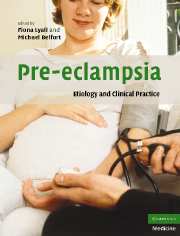Book contents
- Frontmatter
- Contents
- List of contributors
- Preface
- Part I Basic science
- 1 Trophoblast invasion in pre-eclampsia and other pregnancy disorders
- 2 Development of the utero-placental circulation: purported mechanisms for cytotrophoblast invasion in normal pregnancy and pre-eclampsia
- 3 In vitro models for studying pre-eclampsia
- 4 Endothelial factors
- 5 The renin–angiotensin system in pre-eclampsia
- 6 Immunological factors and placentation: implications for pre-eclampsia
- 7 Immunological factors and placentation: implications for pre-eclampsia
- 8 The role of oxidative stress in pre-eclampsia
- 9 Placental hypoxia, hyperoxia and ischemia–reperfusion injury in pre-eclampsia
- 10 Tenney–Parker changes and apoptotic versus necrotic shedding of trophoblast in normal pregnancy and pre-eclampsia
- 11 Dyslipidemia and pre-eclampsia
- 12 Pre-eclampsia a two-stage disorder: what is the linkage? Are there directed fetal/placental signals?
- 13 High altitude and pre-eclampsia
- 14 The use of mouse models to explore fetal–maternal interactions underlying pre-eclampsia
- 15 Prediction of pre-eclampsia
- 16 Long-term implications of pre-eclampsia for maternal health
- Part II Clinical Practice
- Subject index
- References
11 - Dyslipidemia and pre-eclampsia
from Part I - Basic science
Published online by Cambridge University Press: 03 September 2009
- Frontmatter
- Contents
- List of contributors
- Preface
- Part I Basic science
- 1 Trophoblast invasion in pre-eclampsia and other pregnancy disorders
- 2 Development of the utero-placental circulation: purported mechanisms for cytotrophoblast invasion in normal pregnancy and pre-eclampsia
- 3 In vitro models for studying pre-eclampsia
- 4 Endothelial factors
- 5 The renin–angiotensin system in pre-eclampsia
- 6 Immunological factors and placentation: implications for pre-eclampsia
- 7 Immunological factors and placentation: implications for pre-eclampsia
- 8 The role of oxidative stress in pre-eclampsia
- 9 Placental hypoxia, hyperoxia and ischemia–reperfusion injury in pre-eclampsia
- 10 Tenney–Parker changes and apoptotic versus necrotic shedding of trophoblast in normal pregnancy and pre-eclampsia
- 11 Dyslipidemia and pre-eclampsia
- 12 Pre-eclampsia a two-stage disorder: what is the linkage? Are there directed fetal/placental signals?
- 13 High altitude and pre-eclampsia
- 14 The use of mouse models to explore fetal–maternal interactions underlying pre-eclampsia
- 15 Prediction of pre-eclampsia
- 16 Long-term implications of pre-eclampsia for maternal health
- Part II Clinical Practice
- Subject index
- References
Summary
Introduction
The causes of the pregnancy syndrome pre-eclampsia are multifactorial and poorly understood. According to current concepts, the disorder has two principal stages (Redman et al., 1999; Roberts and Hubel, 1999). The first stage is reduced placental perfusion, frequently secondary to abnormal implantation and insufficient remodeling of spiral arteries feeding the intervillous space. The second stage is the maternal response to this condition, modulated by maternal constitution and heredity, and characterized by widespread inflammation and endothelial cell dysfunction. The link between the two stages is an area of intense investigation. It is clear that placental factors are not solely accountable for the maternal manifestations of pre-eclampsia. Intrauterine growth restriction and preterm birth are commonly associated with abnormalities in Stage 1 but without the occurrence of a maternal syndrome. Maternal factors, including pre-pregnancy obesity and insulin resistance, predispose to development of pre-eclampsia. Evidence is accumulating that maternal constitutional predisposition to cardiovascular disease, unmasked or accentuated during the stress of pregnancy, is a key component in the development of pre-eclampsia. Data also suggest that women with a history of pre-eclampsia are at increased risk of cardiovascular disease in later life. Dyslipidemia may play an important role in these interrelationships. This chapter reviews the changes in lipid metabolism that occur with normal pregnancy and pre-eclampsia, and develops the hypothesis that dyslipidemia contributes to both the pathogenesis of preeclampsia and risk of later-life cardiovascular disease.
Pregnancy-induced changes in lipid metabolism
The diverse effects of pregnancy include a profound impact upon lipid metabolism.
- Type
- Chapter
- Information
- Pre-eclampsiaEtiology and Clinical Practice, pp. 164 - 182Publisher: Cambridge University PressPrint publication year: 2007



